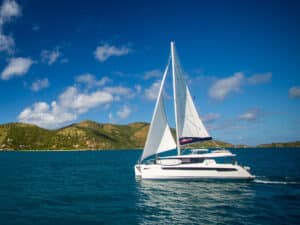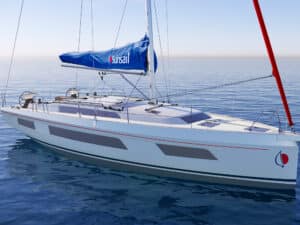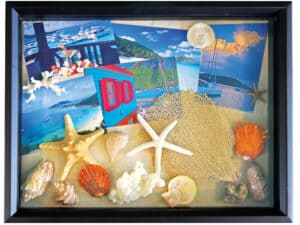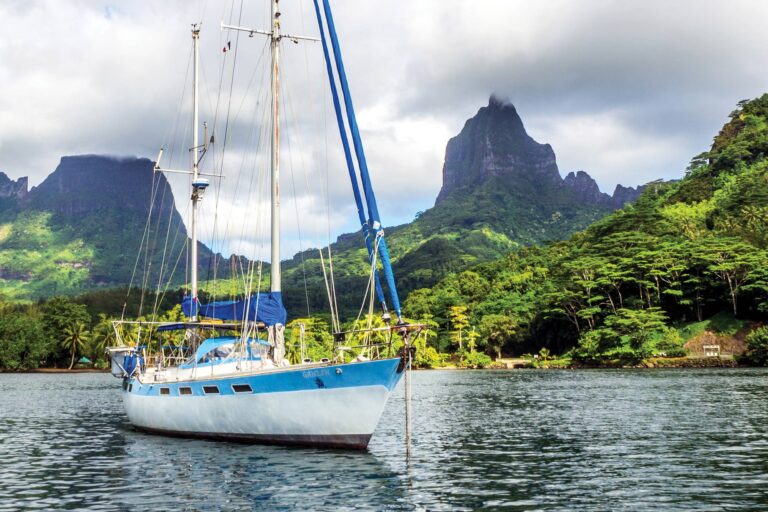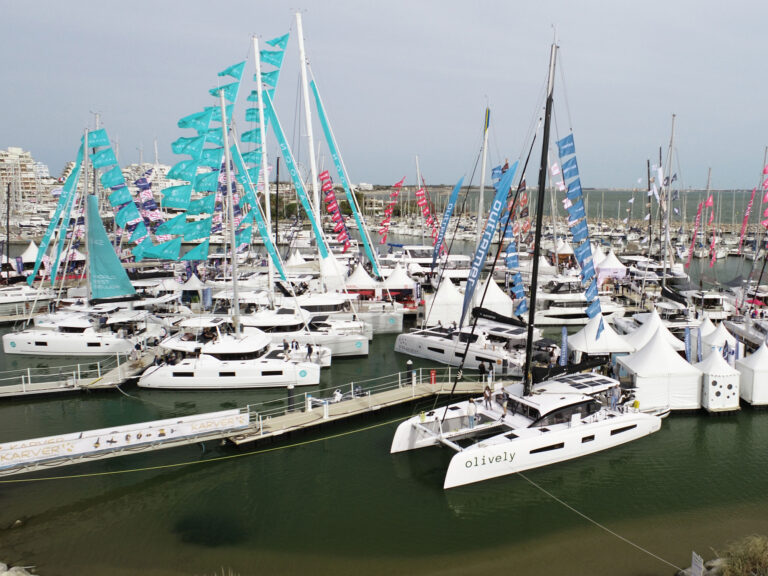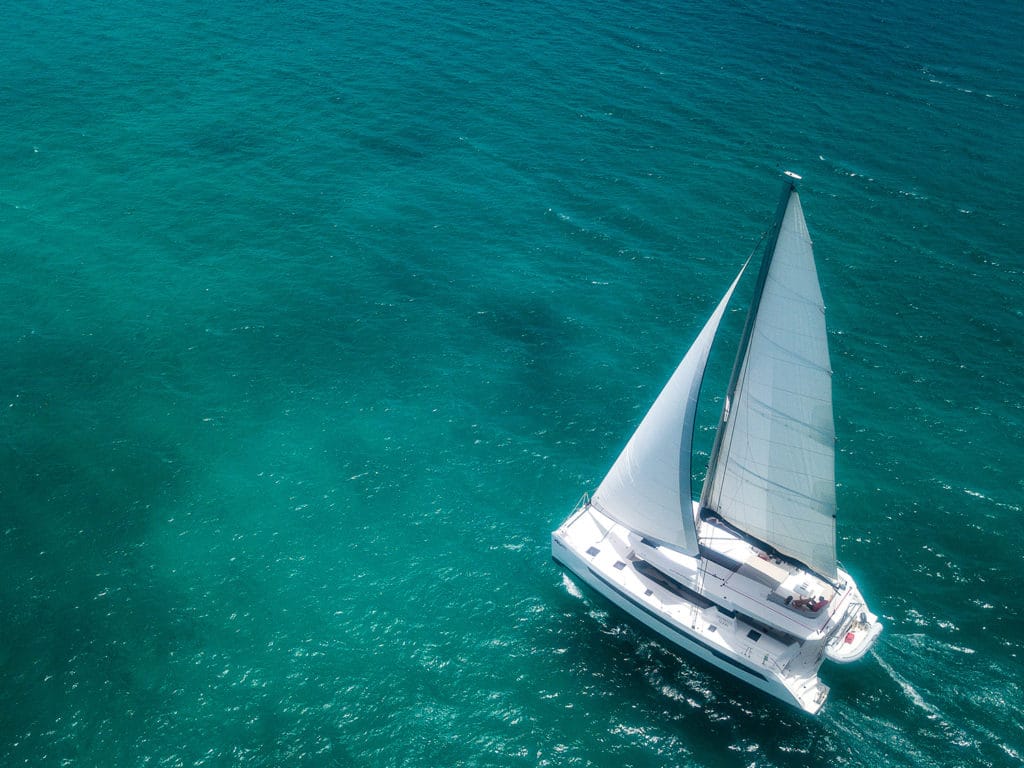
There’s one math problem that almost no boat owner ever wants to calculate: cost of ownership divided by actual days spent sailing. A stance of cheerful delusion might be the best way to accept the hard answer.
This is the problem charter yacht-ownership programs are designed to solve. If you talk with folks who’ve spent many years in the business of selling new boats into charter fleets and operating those fleets, you can expect to hear several cautionary themes: A sailboat is a depreciating asset; owning a charter boat is more a lifestyle choice than a financial investment; beware the aggressive tax-benefit pitch. Yet, by and large, they agree on this: If you love sailing and love traveling but you know that—for the next five years, at least—you won’t be able to devote more than four or eight or maybe even 12 weeks to it, placing a boat in charter will substantially offset the cost of owning it.
Consider this ballpark example from Dream Yacht Charter’s new Fractional Program, introduced this past fall. You put down roughly $200,000 for a 25 percent share in a new 45-foot Bali 4.5 catamaran. In exchange, for the five-year agreement, Dream Yacht covers all of the boat’s operating expenses (dockage, maintenance, insurance and so on), and you receive five weeks’ use on any similar boat at any of Dream Yacht’s 50 bases around the world. Every year of the contract, Dream Yacht sends you 5 percent of your buy-in price: $10,000 per year, or $50,000 over five years. Toward the end of the term, Dream Yachts lists the boat on the open market. If it sells before the end of the charter agreement, you receive your portion of the proceeds. If it doesn’t, Dream Yacht guarantees a 40 percent minimum buy-back value at resale, or $80,000. According to this math ($50,000 plus $80,000), by the end of the five-year term, you get $130,000 back from your original investment, and your total cost amounts to $70,000.
Now here’s where the sailing comes in. The average cost of chartering a Bali 4.5 is about $8,000 per week. The value of chartering a Bali 4.5 for two weeks per year over five years comes to $80,000; four weeks per year, $160,000; five weeks per year, $200,000. The takeaway: If you can go sailing for four weeks a year, with this program, you receive $160,000 in value for the $70,000 you spent. (And the ratio looks better still if you can get out sailing for five weeks a year.)
We’ve looked into the ownership programs offered by several of the major charter companies and charter-management companies around the world. These can be roughly divided into two categories: guaranteed income, or passive models; and variable income, or active models (in which you assume more of a role in managing your boat as a business). In addition, many charter companies offer other programs adapted to such special circumstances as crewed charters, fractional ownership, and special circumstances for particular countries. Each company has its particular quirks; we’ll aim to give an overview from which you can start your own conversations.
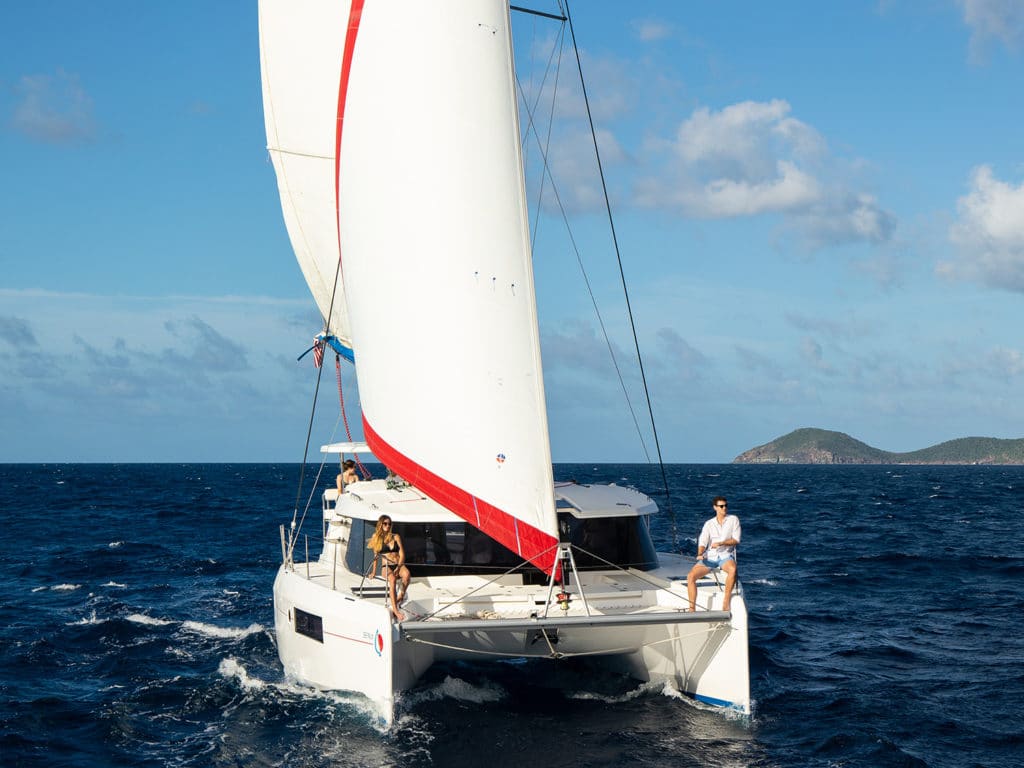
The Passive Model: Guaranteed Income
Full-scale bareboat chartering is just over 50 years old. Before that, you could always find a boat to charter directly from its owner or from a small mom-and-pop operation. But the business as we’d recognize it today began when Jack van Ost founded Caribbean Sailing Charters in Tortola in 1967. Dick Jachney soon followed with Caribbean Yacht Charters in St. Thomas, then Charlie and Ginny Cary started the Moorings in Tortola in 1969.
Jean Larroux has been with the Moorings, on and off, since 1976. Now the company’s yacht sales manager, Larroux is credited with creating the “guaranteed income” model that has become the most popular plan among the world’s largest charter companies.
“Before Ronald Reagan changed the tax laws in 1986, we used to sell basically only variable programs,” Larroux said. “But as the Moorings’ fleet grew, the appetite for boats was such that it was difficult with the variable program to find enough buyers. We sell 150 to 200 boats a year. So we found that to be able to sell that number of boats, we had to focus mainly on a program in which there was virtually no risk.”
The Moorings Guaranteed Income program works like this: You buy the boat and pay the registration fee. The Moorings leases it back for an agreed-upon term—more or less than 60 months, scheduled so the boat doesn’t come out of service during the chartering high season. During that period, the Moorings pays you 9 percent of the purchase price annually, broken into monthly installments. Those payments do not depend on how often your particular boat has been chartered. The company covers all operating costs: dockage, insurance and maintenance. As for sailing, the Moorings offers you as much as 12 weeks of chartering each year, depending on the season, and allows you to use any equivalent boat at any of the company’s bases. The only cost to you is a nominal turnaround fee to cover consumables (water, ice and fuel) each time you start a charter trip.
A ballpark example might look like this: You purchase a 50-foot Moorings 5000 catamaran for $1,000,000. You put down 25 percent and finance $750,000 for 15 years at 6 percent interest. Your monthly payment on the loan comes to about $6,300; each month, the Moorings pays you $7,463 for the lease. If you apply the entire fee to the loan each month, by the end of the term, you’ll owe $505,460. The Moorings estimates the boat’s resale value after five years at $580,000. And, as in our earlier example, the true value comes in sailing weeks—as much as $550,000 worth of chartering over those five years.
Nowadays, most large charter companies and some smaller ones offer a version of the guaranteed-income model. One constraint of this model is the charter company is likely to require that you spec out the boat for optimum charter appeal. If a 45-footer is offered with three cabins or four, for example, it’s likely that you’ll need to go with four. Compare companies.
The charter company you choose might steer you toward a particular make of catamaran. The Moorings sells mainly Robertson & Caine catamarans, branded as either Moorings or Sunsail boats. Dream Yacht sells Bali, Fountaine-Pajot and Lagoon. Horizon Yacht Charters sells Nautitech, Lagoon and Fountaine-Pajot. Navigare sells Fountaine-Pajot, Lagoon, Nautitech and Sunreef.
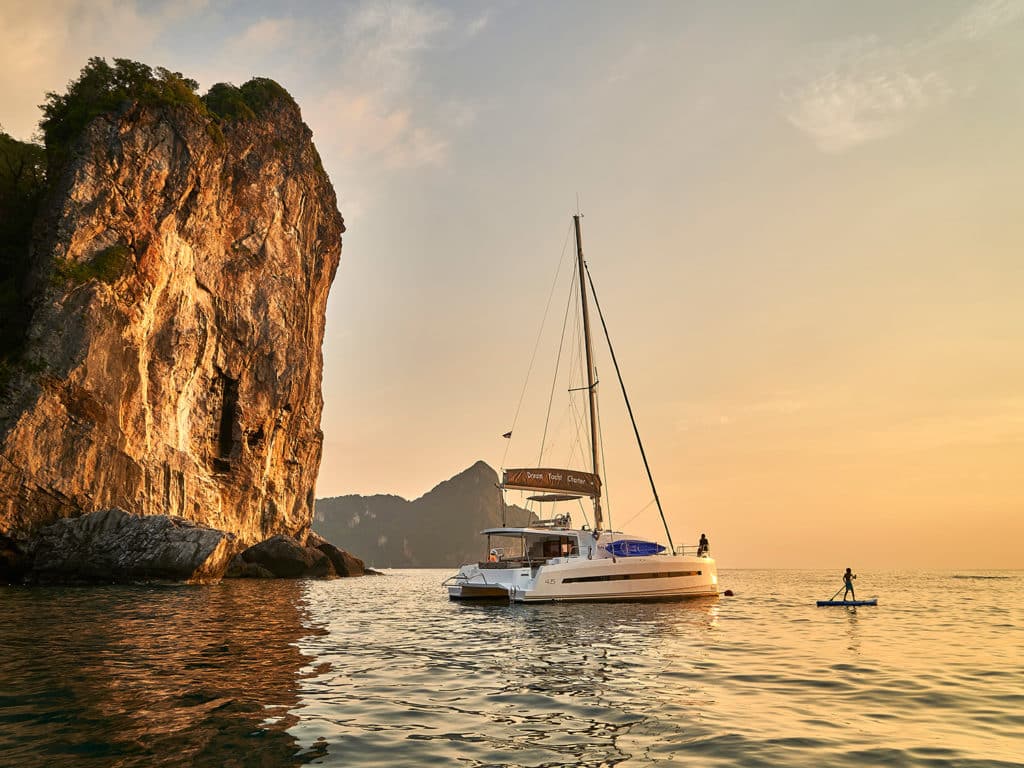
The Active Model: Variable Income
Before the advent of guaranteed-income programs, virtually all charter arrangements were on the variable-income model, and most companies still offer some version of it today. In this case, the costs and proceeds of chartering begin and end with your particular boat. It offers the flexibility for you to either use your boat more often—or use it less, and potentially make more money from it. It also gives you an active role of running your boat as a business, which might have tax implications. (There are no tax breaks for such passive investments as the guaranteed-income model.)
The Catamaran Company is a charter-management company that works exclusively on the variable-income model. Whereas guaranteed-income programs might dictate the way your boat will be laid out and appointed, CatCo offers its owners unlimited choice. “What is always going to charter best,” said Hugh Murray, CEO of CatCo, “is the boat you can put more people on for the cheaper price. So the income projections for an owner buying a four-cabin boat will be higher than for the owner of a three-cabin boat. But in a lot of cases, our owners are likely to want fewer weeks rather than more weeks.”
With a variable program, the boat owner covers all the costs of operating the boat, and the charter operator splits all the income from charters, with the larger portion going to the owner. Horizon Yacht Charters splits 80 percent (to the owner)/20 percent (to the company). CatCo splits 77 percent/23 percent. Dream Yachts and the Moorings split 65 percent/35 percent.
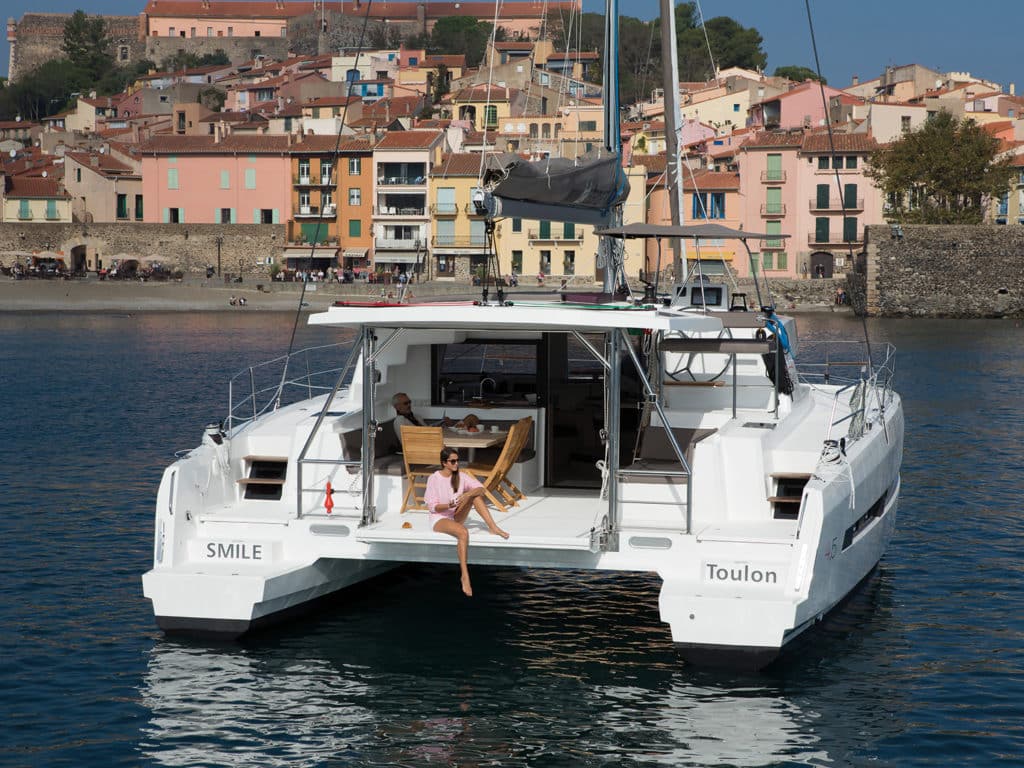
Typically, the charter operator sends the boat owner a statement every month, detailing the charter revenue and the boat’s expenses (docking, water, maintenance, turnaround, electricity, repairs, cleaning and laundry). This statement comes with either a check or a bill. “It goes both ways,” Murray said, “depending on what time of year their boat arrives in the fleet. If a boat arrives in December and starts chartering immediately, you’ll start to get good revenue. If your boat arrives in July, and there’s very little happening in August, September and October, you’re getting a bill.” On average, he says most owners see a return of 9 or 10 percent of the boat’s purchase price per year.
Typically, the charter operator sends the boat owner a statement every month, detailing the charter revenue and the boat’s expenses (docking, water, maintenance, turnaround, electricity, repairs, cleaning and laundry). This statement comes with either a check or a bill. “It goes both ways,” Murray said, “depending on what time of year their boat arrives in the fleet. If a boat arrives in December and starts chartering immediately, you’ll start to get good revenue. If your boat arrives in July, and there’s very little happening in August, September and October, you’re getting a bill.” On average, he says most owners see a return of 9 or 10 percent of the boat’s purchase price per year.
What about tax breaks? Jean Larroux told me that the Moorings does not actively market them as an incentive. “It’s marginal whether you’ll survive a tax audit,” he said.
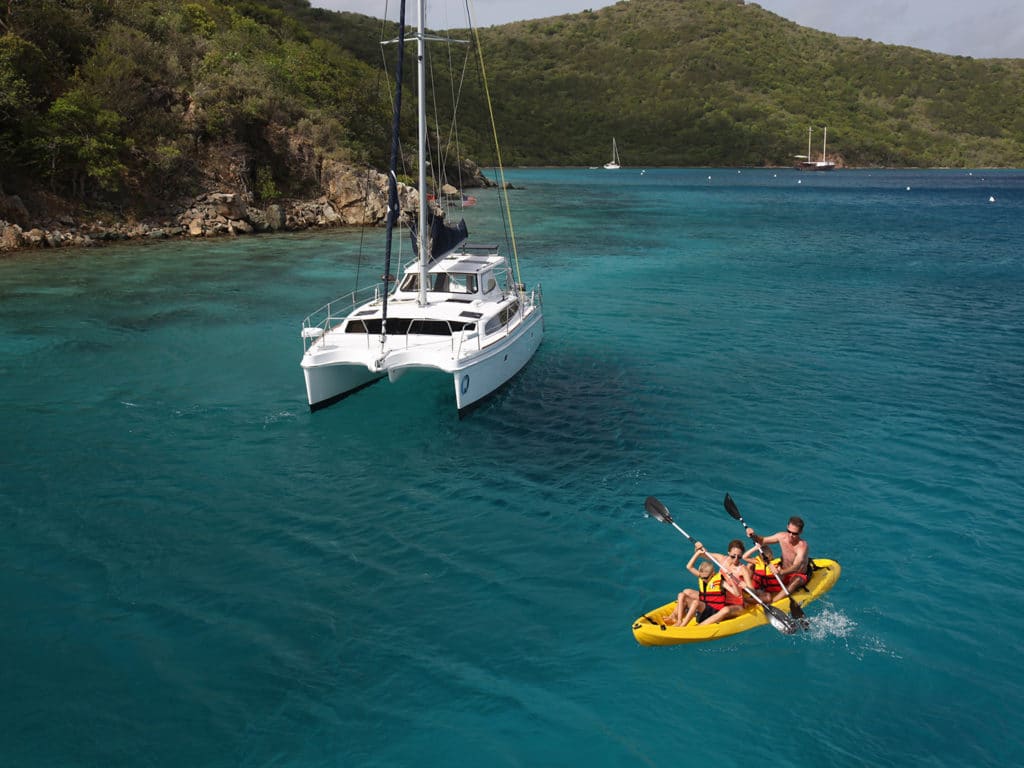
Others I spoke to concur. “We do not market the tax benefits whatsoever,” Murray said. “If somebody wishes to do it, we’re happy to refer them to tax consultants.”
That said, each person I spoke to said they had some clients who were able to make tax benefits work with a variable program. “That’s exactly the difference between our guaranteed-income and our Performance programs,” said Eric Macklin, yacht sales manager for Dream Yacht Charter, referring to the name Dream Yacht gives to its variable-revenue model. The IRS, Macklin says, sets two benchmarks. The first is that the boat owner has to be “actively participating” in the business. The second is that the owner has to show the intention and the ability to earn a profit. As others do, he recommends working closely with a tax adviser first.
The takeaway is that a variable-revenue program might offer you more flexibility in every aspect of owning a boat in charter service: how you spec your boat, how often you use your boat, and how active you’d like to be in the business.
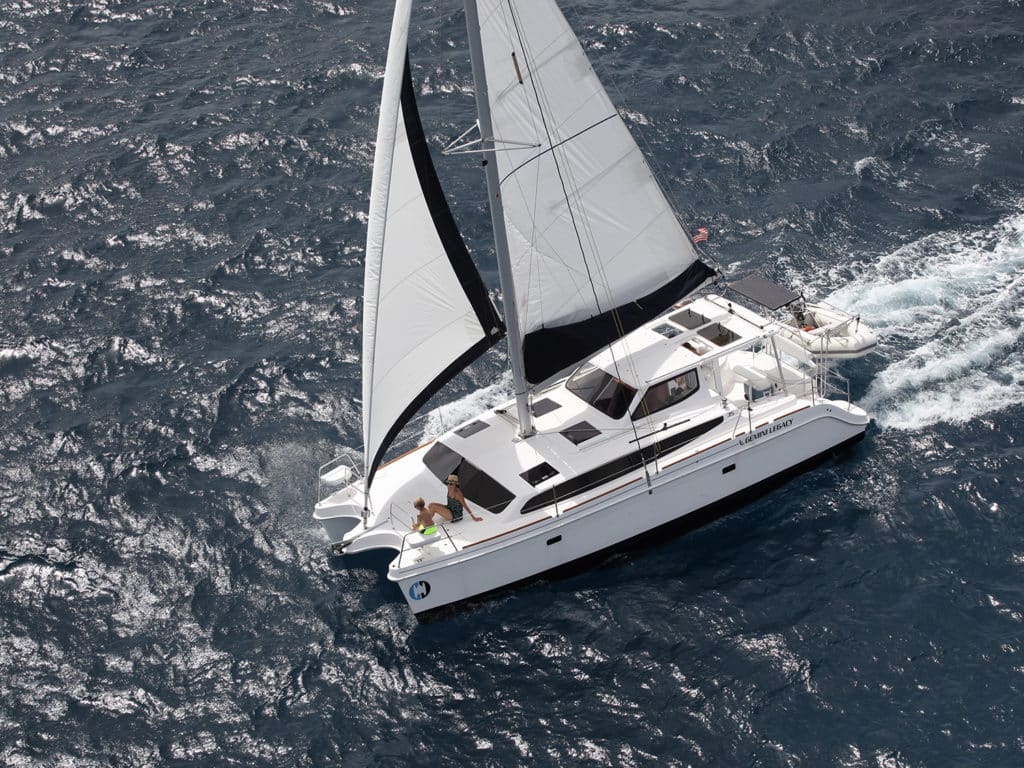
Alternative Models
While the guaranteed-income and variable-income programs are the most popular, ask the charter company about others too. At the top of the piece, we looked at one of these: Dream Yacht’s new Fractional Program, which allows you to buy into part of a boat. Most companies offer programs adapted to setting up your boat for crewed charters, with different levels of involvement from you in the hiring of crew and the marketing of the boat. Ask the Moorings about its Option to Purchase program for boats in such countries as Greece or Thailand, where strict citizenship laws apply; or ask Dream Yacht Charter about its Forward Sale program. Horizon Yacht Charters offers what it calls “the ultimate test sail.” You can charter a boat for up to a week; if within three months you decide to purchase a boat from them, they’ll deduct the cost of the charter from the purchase price.
Whether or not you put your boat in charter service, the reckoning of cost per use always works better the more you sail. But by starting with an honest estimate of how much time you’ll actually get to go sailing—particularly if it’s limited to something between four and 12 weeks a year—putting your boat into charter service might help you suspend the delusions and face the math more cheerfully. Even rationally.
Tim Murphy is a Cruising World editor-at-large.
Charter Companies and Programs
The following list is a selection of the charter companies that contributed to this article:
Dream Yacht Charter
Horizon Yacht Charters
Navigare
Sunsail
The Moorings
The following is a list of charter-management companies that contributed:
Atlantic Cruising Yachts
The Catamaran Company
CYOA
Sail Caribe/Atlas Yacht Sales
TMM/Tortola Marine Management
For more details, see Cruising World‘s Owning a Charter Sailboat
Charter-Ownership Programs
The Catamaran Company: founded 1989; sells Fountaine-Pajot, Gemini, Lagoon and Nautitech cats, each spec’d by the owner. The charter-management operation has one base in the BVI, operating 31 boats at press time. Active model: variable income, based on your particular boat.
Dream Yacht Charter: founded in 2000; sells Bali, Fountaine-Pajot and Lagoon cats. Offers guaranteed-income, variable-income, fractional and crewed-yacht programs. The charter company has more than 1,000 boats in service at 50 bases around the world.
Horizon Yacht Charters: founded 1998; sells Fountaine-Pajot, Lagoon and Nautitech cats. Guaranteed income or split-revenue programs available. The charter company operates 120 boats at three bases in the Caribbean.
Navigare: founded in 2001; Offices in Sweden, Croatia and the Caribbean; Sells Fountaine-Pajot, Lagoon, Nautitech and Sunreef cats. Guaranteed-income or variable-income programs available, among others. The company operates 300 boats in nine countries, with a strong presence in Europe.
The Moorings/Sunsail: The Moorings was founded in 1969. Now, together with Sunsail, the company is owned by Travelopia, a travel company that comprises 50 brands, specializing in sailing, safaris, sports tours and Arctic expeditions. The Moorings and Sunsail sell catamarans built by Robertson & Caine in Cape Town, South Africa. These boats are branded according to their use: A 45-footer for private ownership is branded as a Leopard 45; for charter, a Moorings 4500 or a Sunsail 454. For a limited time, the Moorings is also selling Lagoon cats. Guaranteed-income or variable-income programs available, among others. The company operates 840 charter boats at more than 20 bases around the world. Every year it brings between 150 and 200 new boats into its fleet.


